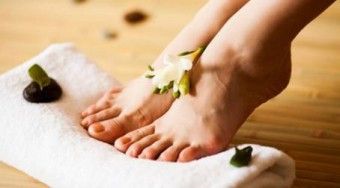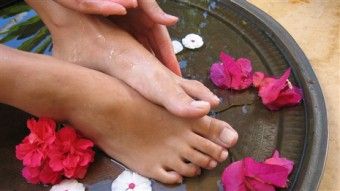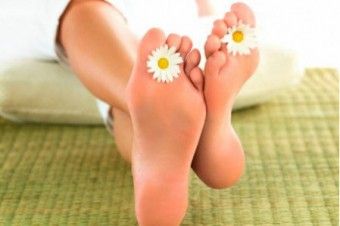Many dream of beautiful legs with velvety delicate skin, but this can only be achieved with regular foot care. In this article, we will discuss the main methods of dealing with common problems such as corns, and cracks in the heels and feet..
Causes of Rough Heels

Just one week of such procedures – and your legs will become soft and soft, like a baby. But sometimes the problem of such an unhealthy state of the legs lies in metabolic disorders, then in addition to skin care, treatment of the discovered disease is required.
The soles of the feet become rough and rough for the following reasons:
- excessive dryness of the skin;
- prolonged stay on the legs;
- wearing uncomfortable shoes;
- contact of feet with synthetic things;
- inadequate foot care.
Often the causes of this condition of the legs is an insufficient amount of vitamins in the body or poor blood circulation in the feet. With poor blood circulation, the problem will also be accompanied by varicose veins in the lower extremities. Hormonal disruptions are another cause of gross and cracked feet..
Thus, if the procedures and the use of heel care products did not bring positive results, it is necessary to undergo an examination to identify the true cause of this condition of the feet.
How to care for heels?
To prevent the appearance of dryness and roughness of the skin on the feet, you need to ensure proper and regular care of your legs. In the summer, every time before sun exposure, you need to lubricate the skin with a nourishing and softening cream.
To enhance blood circulation in the lower extremities, periodically do massage using moisturizing cosmetics. It is not necessary to buy expensive products, you can prepare them yourself using folk methods to combat the problem.
Care of the soles of the feet should consist of baths, cleansing of dead cells, the use of nourishing masks and creams. Some girls and women use a special device for heel care, it can be a pumice stone or razor.

Foot baths
If your feet need intensive care, you need to regularly do foot baths that soften and nourish the skin..
The following bath recipes are the most popular:
- With apple cider vinegar. The procedure is ideal for very rough skin. For its implementation, add 2 tablespoons of apple cider vinegar to warm water, hold your feet in it for 10-15 minutes. After that, take a soft brush and massage the soles well with it. If a thick layer of skin has formed on the soles, you will need a stiff brush or pumice stone, with which you need to carefully rub your feet. Rinse your feet with cool water and apply a moisturizer;
- Soda-soap. For a liter of water you will need 2 tablespoons of soda and a spoonful of liquid soap. Dissolve these components in warm water, lower your legs, after 10 minutes, rub with a brush and apply a nutrient;
- With white clay. Such a foot bath softens the skin of the legs well, it is recommended to use it only after removing the coarse layer. To do this, dissolve a little white clay in warm water and hold your feet for 20 minutes;
- Starchy. Ideal for rough heels. Dissolve 2 tablespoons of potato starch in a small amount of cold water, pour it into warm water. The duration of the procedure is 20 minutes..
Moisturizing and nourishing masks for heels
There are many simple and quite effective folk recipes for heel care, which are very convenient to use at home. After applying foot baths to soften the skin, masks are applied on the soles.
Here are some available foot mask recipes to help you solve your problems:
- grind fresh stalks and leaves of celandine on a blender or meat grinder, apply the prepared slurry to the feet, keep all night
- grate the feet with lemon juice, rinse with water after 10 minutes;
- mix sour cream with cottage cheese, apply to the soles, hold for 15 minutes;
- crushed cabbage leaves, which need to be applied to problem areas for half an hour, will help get rid of cracks in the legs;
- Aloe also has a great softening effect, its gruel is applied to problem areas and left for half an hour;
- your legs will become tender if you rub lightly warmed olive oil daily into the feet;
- with corns and corns effectively mashed potato will be.
If your heels are too coarse and rough, it is better to apply such masks at night, wrapping your feet in plastic wrap, and putting on warm wool socks. Do not forget that to soften the skin on the soles of the feet, masks and baths you need to do 2-3 months.
Cracking techniques for heels

If the heels are already cracked, you can use this method of treating wounds: cut the apple into cubes, boil it in a small amount of milk until a pulp consistency is obtained. On a sore spot, apply the prepared milk-apple medicine in a thick layer, wrap it in several layers with gauze, hold for 40 minutes, rinse with warm water.
An infusion of 5 tablespoons of such an herbal mixture – mint, chamomile, birch leaf – heals sick heels well. A mixture of herbs pour two liters of boiling water, leave for an hour, strain and make a foot bath. If you have cracks, completely eliminate the use of a heel care device.
Perform heel care at least once a week, and your legs will be silky and soft!










